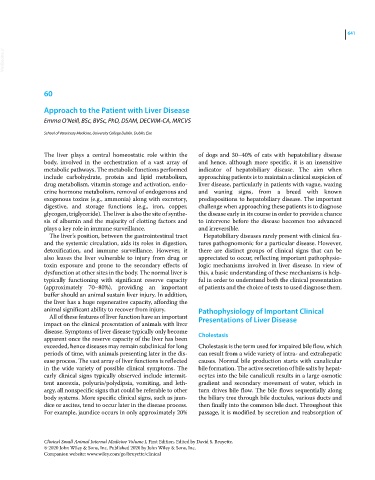Page 673 - Clinical Small Animal Internal Medicine
P. 673
641
VetBooks.ir
60
Approach to the Patient with Liver Disease
Emma O’Neill, BSc, BVSc, PhD, DSAM, DECVIM-CA, MRCVS
School of Veterinary Medicine, University College Dublin, Dublin, Eire
The liver plays a central homeostatic role within the of dogs and 30–40% of cats with hepatobiliary disease
body, involved in the orchestration of a vast array of and hence, although more specific, it is an insensitive
metabolic pathways. The metabolic functions performed indicator of hepatobiliary disease. The aim when
include carbohydrate, protein and lipid metabolism, approaching patients is to maintain a clinical suspicion of
drug metabolism, vitamin storage and activation, endo- liver disease, particularly in patients with vague, waxing
crine hormone metabolism, removal of endogenous and and waning signs, from a breed with known
exogenous toxins (e.g., ammonia) along with excretory, predispositions to hepatobiliary disease. The important
digestive, and storage functions (e.g., iron, copper, challenge when approaching these patients is to diagnose
glycogen, triglyceride). The liver is also the site of synthe- the disease early in its course in order to provide a chance
sis of albumin and the majority of clotting factors and to intervene before the disease becomes too advanced
plays a key role in immune surveillance. and irreversible.
The liver’s position, between the gastrointestinal tract Hepatobiliary diseases rarely present with clinical fea-
and the systemic circulation, aids its roles in digestion, tures pathognomonic for a particular disease. However,
detoxification, and immune surveillance. However, it there are distinct groups of clinical signs that can be
also leaves the liver vulnerable to injury from drug or appreciated to occur, reflecting important pathophysio-
toxin exposure and prone to the secondary effects of logic mechanisms involved in liver disease. In view of
dysfunction at other sites in the body. The normal liver is this, a basic understanding of these mechanisms is help-
typically functioning with significant reserve capacity ful in order to understand both the clinical presentation
(approximately 70–80%), providing an important of patients and the choice of tests to used diagnose them.
buffer should an animal sustain liver injury. In addition,
the liver has a huge regenerative capacity, affording the
animal significant ability to recover from injury. Pathophysiology of Important Clinical
All of these features of liver function have an important Presentations of Liver Disease
impact on the clinical presentation of animals with liver
disease. Symptoms of liver disease typically only become Cholestasis
apparent once the reserve capacity of the liver has been
exceeded, hence diseases may remain subclinical for long Cholestasis is the term used for impaired bile flow, which
periods of time, with animals presenting later in the dis- can result from a wide variety of intra‐ and extrahepatic
ease process. The vast array of liver functions is reflected causes. Normal bile production starts with canalicular
in the wide variety of possible clinical symptoms. The bile formation. The active secretion of bile salts by hepat-
early clinical signs typically observed include intermit- ocytes into the bile canaliculi results in a large osmotic
tent anorexia, polyuria/polydipsia, vomiting, and leth- gradient and secondary movement of water, which in
argy, all nonspecific signs that could be referable to other turn drives bile flow. The bile flows sequentially along
body systems. More specific clinical signs, such as jaun- the biliary tree through bile ductules, various ducts and
dice or ascites, tend to occur later in the disease process. then finally into the common bile duct. Throughout this
For example, jaundice occurs in only approximately 20% passage, it is modified by secretion and reabsorption of
Clinical Small Animal Internal Medicine Volume I, First Edition. Edited by David S. Bruyette.
© 2020 John Wiley & Sons, Inc. Published 2020 by John Wiley & Sons, Inc.
Companion website: www.wiley.com/go/bruyette/clinical

